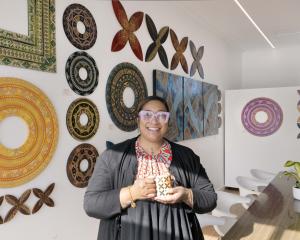Digging into the Dunedin Public Art Gallery's collection has been very exciting for its newest curator, Lucy Hammonds. On the eve of her first exhibition, she tells Rebecca Fox about her love of art.
A belief in art and what artists do inspires curator Lucy Hammonds to help communicate their ideas to the world.
''I love what I do. It's a real pleasure. I enjoy the potential of exhibiting in communicating ideas that art delivers to us.''
Ms Hammonds, who grew up in Auckland and did the critical studies programme at Unitec School of Design, has moved from Hawkes Bay with her family to Dunedin for the job.
''The whole family was excited about a move to Dunedin.''
She left a position curating art and design collections at MTG (Museum Theatre Gallery) Hawke's Bay, a combined museum-art gallery, to move south.
Dunedin Public Art Gallery's reputation nationally and internationally as one which supported curators, it was the first public art gallery in New Zealand to establish a professional curatorial profession, was a big attraction, she said.
''I set out at the start of my career to work in institutions I really admired and had interesting collections. This had the exact combination of factors.''
Added to that was the city's rich cultural and historical heritage and a community which really valued art and what the gallery provided so the move was very appealing.
''We're not put off by the cold.''
Since she arrived a few months ago, Ms Hammonds has been getting to know the collection and the artists it worked with and developing her first exhibition.
''It's about drilling down and understanding what idiosyncrasies each art collection may have to find the stories and working how to make them available to an audience.''
Her first exhibition, ''Wanderings'', allowed her to delve into the collection and see where it took her.
The starting point was travel and New Zealand's ''tyranny of distance'' and how it informed the work of the collection's artists, she said.
''It was an interesting proposition and one that enabled me to work across the collection, so the exhibition spans decades and is very eclectic.''
She had focused on small groups of work which looked at travel in a variety of ways.
The oldest group of drawings was from the 1840s and 1850s, by East India Co surveyor Walter Sherwill, and had not been exhibited before.
''They're fabulously interesting drawings of the time that were sent back to England to be reproduced for the Illustrated London News.''
They had been donated to the gallery by a Dunedin-based descendant of Sherwill.
This contrasted with the works of Auckland artist Julian Dashper, whose installation of 400 35mm slides from the 1990s was about how artists reached out to galleries and how art was taught.
''The 35mm slide was the currency exchange for art pre-dating the ubiquitous internet.''
Her aim was to help the audience connect the works and ''find avenues they can delve into'', she said.
''The exhibition moved divergent ranges of works in an interesting way of presenting different art experiences to people.''
She had enjoyed the experience of putting together the exhibition.
''You inevitably find it leading somewhere you weren't expecting it to go. That is the beauty of the gallery.''
For her, the process of putting together an exhibition could be overwhelming, as decisions on where it would go needed to be made.
''For me, the really interesting part is once you set some parameters and have selected the artworks and you start researching ... to try and knit together the relationship between the works.
''It's a storytelling exercise, making your own connections and challenging the audience to find their way.''
It was not about dictating what the audience was to think, but ''opening the door''.
''It's about figuring out how to light other people up to possibilities, that is the cool thing.''
People did not have to like everything they saw and it was one of the gallery's strengths that it had such a diverse collection, she said.
''One of my most illuminating experiences was something that really bothered me. Artists don't always set out to please you.''
She hoped people would attend the show expecting one thing but walking away thinking about something else.
''That is the great thing about art.''












